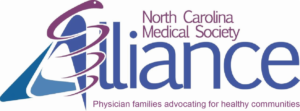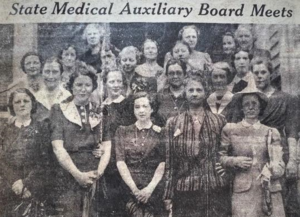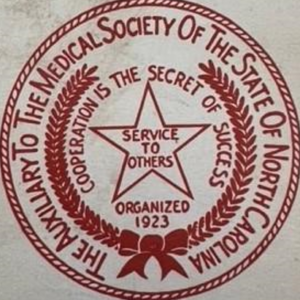
RALEIGH — Next year the North Carolina Medical Society Alliance celebrates 100 years! The Alliance works to improve the health of all people in North Carolina.
In advance of the anniversary, NCMS Alliance is sharing some history and stories of it’s history. Here is the second in a series.
Reviewing the 1940s…

On Monday Afternoon, April 15, 1940 the State Medical Auxiliary Board Meets
The North Carolina Medical Society Auxiliary in the 1940s
The Auxiliary to the Medical Society of North Carolina began the decade by expanding its sanitorium bed project to the Western Sanitorium in Asheville, later naming that bed for Dr. Martin Stevens. Soon, the developments of World War II influenced members’ efforts. In 1941, a National Defense Chairman led the Auxiliary in a project to collect surgical instruments and medical supplies called Aid to Britain. In 1942, members funded the USS Fremont battle dressing station and sold Mercy Emblems for emergency medical field kits. By 1943, Auxiliaries were directing much of their energy to the war effort, meeting troop trains with doughnuts and coffee, knitting and sewing, using their endowments to purchase war bonds, and raising money for the Medical and Surgical Relief Committee. In 1944, 210 members gave 113, 355 hours to war service committees!
The Auxiliary continued other projects during the war. In 1944 the group established the Cooper Bed, named for George Martin Cooper, MD, in the Eastern Sanitorium in Wilson. During the poliomyelitis epidemic in that same year, members assisted clinics and physicians to get through the crisis, which hit some areas of the state very hard, and assisted in the gamma globulin and Salk mass vaccine clinics. Members also volunteered in hospitals by staffing canteens, creating library services for patients, contributing linens, and furnishing rooms in hospitals and nurses’ homes.
A shortage of graduate nurses followed the war. So, in 1948 the Auxiliary started Future Nurses Clubs which involved hosting teas, giving hospital tours and other activities to generate interest in nursing among high school students. The Auxiliary provided loans and scholarships for qualified students to study nursing.
By 1949, when the annual meeting was held in Pinehurst, membership in the Auxiliary to the Medical Society of North Carolina had grown to 1321 members. Forty-three local auxiliaries existed with 10 of those reorganizing during the 1940s. Yearly dues increased to $2.00 in 1948 with $1.00 going to national dues. Half of the state dues, or fifty cents, went to various Memorial Bed funds in state sanitoria. Other highlights of the 1940s include–
1940: The Auxiliary supported a legislative bill requiring a medical exam for a marriage license and a Wassermann test for pregnant women.
1941: Auxiliary members compiled a mailing list of physicians’ wives. The work of the Auxiliary was divided among eleven committees. Chairmen of these committees kept notebooks of their projects that were passed on to their successors.
1942: The Board of Directors met only twice a year instead of four times.
1945: Members continued to be active in the war effort. The annual meeting was canceled to conserve gas and oil. The Auxiliary president traveled by public bus.
1946: The State Auxiliary received a Treasury Award for Patriotic Service. Members made surgical dressings for cancer patients and kept up with medical legislation.
1947: Members adopted the motto, Service to Others. Frederick Taylor, MD of High Point designed the first state seal.
1949: The Public Relations Committee began its work. Members staged a write-in to legislators to help defeat national compulsory health insurance.

Mrs. Sidney Smith (Melissa) President: 1941-42

Mrs. C. F. Strosnider (Anna), President 1939-1940

The 1st State Seal
For more information on the North Carolina Medical Society Alliance or to join click here.
